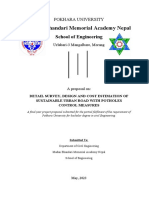0 ratings0% found this document useful (0 votes)
330 viewsCivil Engineering
Civil Engineering
Uploaded by
Realtor IndiaCivil engineering is a broad professional engineering discipline that deals with designing, constructing, and maintaining infrastructure and structures in the built environment. Civil engineers work on projects like roads, bridges, buildings, dams, airports, and more. The term "civil engineering" was originally used to distinguish non-military engineering from military engineering. Civil engineering requires the application of scientific principles and knowledge of materials, structures, and research.
Copyright:
© All Rights Reserved
Available Formats
Download as PDF, TXT or read online from Scribd
Civil Engineering
Civil Engineering
Uploaded by
Realtor India0 ratings0% found this document useful (0 votes)
330 views3 pagesCivil engineering is a broad professional engineering discipline that deals with designing, constructing, and maintaining infrastructure and structures in the built environment. Civil engineers work on projects like roads, bridges, buildings, dams, airports, and more. The term "civil engineering" was originally used to distinguish non-military engineering from military engineering. Civil engineering requires the application of scientific principles and knowledge of materials, structures, and research.
Original Description:
Civil engineering Basic Information
Original Title
Civil engineering
Copyright
© © All Rights Reserved
Available Formats
PDF, TXT or read online from Scribd
Share this document
Did you find this document useful?
Is this content inappropriate?
Civil engineering is a broad professional engineering discipline that deals with designing, constructing, and maintaining infrastructure and structures in the built environment. Civil engineers work on projects like roads, bridges, buildings, dams, airports, and more. The term "civil engineering" was originally used to distinguish non-military engineering from military engineering. Civil engineering requires the application of scientific principles and knowledge of materials, structures, and research.
Copyright:
© All Rights Reserved
Available Formats
Download as PDF, TXT or read online from Scribd
Download as pdf or txt
0 ratings0% found this document useful (0 votes)
330 views3 pagesCivil Engineering
Civil Engineering
Uploaded by
Realtor IndiaCivil engineering is a broad professional engineering discipline that deals with designing, constructing, and maintaining infrastructure and structures in the built environment. Civil engineers work on projects like roads, bridges, buildings, dams, airports, and more. The term "civil engineering" was originally used to distinguish non-military engineering from military engineering. Civil engineering requires the application of scientific principles and knowledge of materials, structures, and research.
Copyright:
© All Rights Reserved
Available Formats
Download as PDF, TXT or read online from Scribd
Download as pdf or txt
You are on page 1of 3
Civil engineering
Civil engineering is a professional engineering discipline that deals with the
design, construction, and maintenance of the physical and naturally built
environment, including public works such as roads, bridges, canals, dams,
airports, sewerage systems, pipelines, structural components of buildings,
and railways
Civil engineers design, construct, maintain and improve the
physical environment, including; bridges, tunnels, roads, railways, canals,
dams, buildings, flood and coastal defences, airports and other
large structures. The term ‘civil’ engineer was originally coined to distinguish
it from military engineering.
Civil engineering is a broad profession that encompasses a range of subjects
that can be developed as specialisms, such as:
Structures.
Transportation.
Environmental.
Maritime.
Geotechnical.
Hydraulic.
Sanitary.
Water.
Whilst some of these specialisms may be considered sub-disciplines of civil
engineering, subjects such as structural engineering (which focuses on
the design, assessment and inspection of structures to ensure that they are
efficient and stable) may now be considered engineering disciplines in their
own right.
In 2007, the Institution of Civil Engineers (ICE) Council adopted the
following definition of civil engineering, ‘Civil Engineering is a vital art,
working with the great sources of power in nature for the wealth and well-
being of the whole of society. Its essential feature is the exercise of
imagination to engineer the products and processes, and develop the people
needed to create and maintain a sustainable natural and built environment.
It requires a broad understanding of scientific principles,
a knowledge of materials and the art of analysis and synthesis. It also
requires research, team working, leadership and business skills. A civil
engineer is one who practises all or part of this art.'
Civil engineers will normally begin the process of qualification by taking a
three-year BSc or Bachelor of Engineering (BEng) degree or a four-year
Masters (MEng) degree in civil engineering. Alternatively, practicing
technicians can take a BTEC HNC/HND or foundation degree in civil
engineering.
This is likely to be followed by entering a company's graduate training
scheme for one or two years and joining a professional body, such as the
Institution of Civil Engineers to allow progress towards incorporated or
chartered status. Incorporated engineers will tend to work on the day-to-
day management of projects whilst chartered engineers may have a more
strategic role.
Civil engineering is traditionally broken into a number of sub-disciplines. It
is considered the second-oldest engineering discipline after military
engineering and it is defined to distinguish non-military engineering from
military engineering.[4] Civil engineering takes place in the public sector from
municipal through to national governments, and in the private sector from
individual homeowners through to international companies.
Civil engineering as a discipline
Civil engineering is the application of physical and scientific principles for
solving the problems of society, and its history is intricately linked to
advances in the understanding of physics and mathematics throughout
history. Because civil engineering is a wide-ranging profession, including
several specialized sub-disciplines, its history is linked to knowledge of
structures, materials science, geography,
geology, soils, hydrology, environment, mechanics and other fields.
Throughout ancient and medieval history most architectural design and
construction was carried out by artisans, such
as stonemasons and carpenters, rising to the role of master builder.
Knowledge was retained in guilds and seldom supplanted by advances.
Structures, roads, and infrastructure that existed were repetitive, and
increases in scale were incremental
One of the earliest examples of a scientific approach to physical and
mathematical problems applicable to civil engineering is the work
of Archimedes in the 3rd century BC, including Archimedes Principle, which
underpins our understanding of buoyancy, and practical solutions such
as Archimedes' screw. Brahmagupta, an Indian mathematician, used
arithmetic in the 7th century AD, based on Hindu-Arabic numerals, for
excavation (volume) computations.
You might also like
- Careers in Civil EngineeringDocument4 pagesCareers in Civil EngineeringJes NapiñasNo ratings yet
- Challenges in Civil Engineering Construction in NigeriaDocument65 pagesChallenges in Civil Engineering Construction in NigeriaKingsAustineSugarMan75% (4)
- Test Bank For M Advertising 2nd Edition Arens, Schaefer, WeigoldDocument61 pagesTest Bank For M Advertising 2nd Edition Arens, Schaefer, Weigolda354771415100% (2)
- State and District Academic Standards Professional DevelopmentDocument11 pagesState and District Academic Standards Professional Developmentapi-47562837750% (2)
- Sub-Disciplines: Civil Engineering Is A Professional Engineering Discipline That Deals With The DesignDocument15 pagesSub-Disciplines: Civil Engineering Is A Professional Engineering Discipline That Deals With The DesignMitha Cyrus Chingu Elf100% (1)
- Lecture Notes For IntroductionDocument9 pagesLecture Notes For Introductiongiftysithole20No ratings yet
- 03 Module 3 - Construction Engineering and ManagementDocument9 pages03 Module 3 - Construction Engineering and ManagementEricka HuseñaNo ratings yet
- Civil Engineering and Society and Other ProfessionsDocument4 pagesCivil Engineering and Society and Other ProfessionsPaul Bronzon DurensNo ratings yet
- Final Research (Addisu Leta, Structural Eng)Document99 pagesFinal Research (Addisu Leta, Structural Eng)Mohammed B Tuse100% (1)
- Engineering OrientationDocument5 pagesEngineering Orientations. dela cruz, BLJDONo ratings yet
- Introduction Civil Engineering MaterialsDocument4 pagesIntroduction Civil Engineering MaterialsBSMK60100% (1)
- The History of Civil EngineeringDocument4 pagesThe History of Civil Engineeringopata cletus100% (2)
- SNDJDDocument14 pagesSNDJDKennethNo ratings yet
- Civil Engineering BrochureDocument2 pagesCivil Engineering Brochuretimmytanks40No ratings yet
- Construction Engineering and ManagementDocument10 pagesConstruction Engineering and ManagementMae Kyla Moreno100% (1)
- Lecture 7 - Current Fields of Civil Engineering Construction ManagementDocument31 pagesLecture 7 - Current Fields of Civil Engineering Construction ManagementMels AlcariaNo ratings yet
- Structural Engineering and Construction Engineering and ManagementDocument3 pagesStructural Engineering and Construction Engineering and Management2ne1 BlackjackNo ratings yet
- FYP Civil Residential BuildingDocument56 pagesFYP Civil Residential BuildingCivilmaze100% (1)
- History of Civil Engineering: CEORNT120Document41 pagesHistory of Civil Engineering: CEORNT120Jay Grijaldo100% (1)
- Introduction To AutoCadDocument10 pagesIntroduction To AutoCadnemi.ahmedabadNo ratings yet
- Construction Engineering and ManagementDocument16 pagesConstruction Engineering and Managementred velvetNo ratings yet
- Course Contents 1. SpecificationsDocument2 pagesCourse Contents 1. SpecificationsTarmok HirpoNo ratings yet
- Highways Engineering IDocument241 pagesHighways Engineering IAnonymous 2z9S8CqNo ratings yet
- Review of Road Network Design: A Case Study of Kiri Kasama LGA - Jigawa StateDocument8 pagesReview of Road Network Design: A Case Study of Kiri Kasama LGA - Jigawa StateInternational Journal of Innovative Science and Research TechnologyNo ratings yet
- Group 2 Structural and Construction Engineering Management Report Day 1Document57 pagesGroup 2 Structural and Construction Engineering Management Report Day 12ne1 BlackjackNo ratings yet
- Hand CalculationDocument3 pagesHand CalculationAmiko BravoNo ratings yet
- Lecture 9 Fundamentals of BIMDocument2 pagesLecture 9 Fundamentals of BIMAlNaeemNo ratings yet
- 12 Types of Civil Engineering BranchesDocument4 pages12 Types of Civil Engineering BranchesfeaponteNo ratings yet
- Car ParkingDocument2 pagesCar Parkingashish pashineNo ratings yet
- Course Syllabus - Mechanics of MaterialsDocument6 pagesCourse Syllabus - Mechanics of MaterialsAlan Mauricio InsaustiNo ratings yet
- Construction Engineering and Management (Group 4) : Topics To Be DiscussedDocument6 pagesConstruction Engineering and Management (Group 4) : Topics To Be DiscussedAllen Jierqs SanchezNo ratings yet
- CIVIL ENGINEERING PRACTICE IN NIGERIA AssignmentDocument8 pagesCIVIL ENGINEERING PRACTICE IN NIGERIA AssignmentOMOTOYINBO MICHAELNo ratings yet
- MCA 2024 Syllabus With CreditPoints - 13092024Document90 pagesMCA 2024 Syllabus With CreditPoints - 13092024Shubham PuriNo ratings yet
- Opportunities in Civil EngineeringDocument34 pagesOpportunities in Civil EngineeringJagadeesh SundaramNo ratings yet
- History of AutocadDocument4 pagesHistory of AutocadNivea ZuniegaNo ratings yet
- Project Feasibility Study Technical AspectDocument10 pagesProject Feasibility Study Technical Aspectjaiscey valenciaNo ratings yet
- Construction Technology Chapter OneDocument20 pagesConstruction Technology Chapter OneLego EdrisaNo ratings yet
- Module 4 - QuantityDocument12 pagesModule 4 - QuantityKimberly Wealth Meonada MagnayeNo ratings yet
- Module 3 CE Orientation-1Document14 pagesModule 3 CE Orientation-1Adrian De GuzmanNo ratings yet
- Strength Assessing of BridgesDocument24 pagesStrength Assessing of BridgesManjunath_ylkNo ratings yet
- Civil Engineering OrientationDocument1 pageCivil Engineering OrientationMagdalena TabaniagNo ratings yet
- Introduction To Engineering GraphicsDocument38 pagesIntroduction To Engineering GraphicsSurajMeshram100% (1)
- Proposal IncompleteDocument13 pagesProposal Incompletesujan gautam0% (1)
- Notes 06c PDFDocument5 pagesNotes 06c PDFEsmailAlshogaryNo ratings yet
- Economics (Geometric Gradient - chp#2)Document8 pagesEconomics (Geometric Gradient - chp#2)api-26367767No ratings yet
- Abandoned Road OsunDocument9 pagesAbandoned Road OsunetopjacobNo ratings yet
- Sample Civil Engineer ResumeDocument1 pageSample Civil Engineer ResumeKen Johnson100% (1)
- New Harmonized Civil Eng'g CariclumDocument150 pagesNew Harmonized Civil Eng'g CariclumMinilik Tikur Sew100% (1)
- Code of Ethics For CE - Part 1Document16 pagesCode of Ethics For CE - Part 1Jomarie AlcanoNo ratings yet
- Construction Technology PDFDocument4 pagesConstruction Technology PDFkrunal suthar100% (1)
- Construction Engineering and Management: Presented By: Divinagracia, Fajardo, Famini and FerrerDocument22 pagesConstruction Engineering and Management: Presented By: Divinagracia, Fajardo, Famini and FerrerEdward FerrerNo ratings yet
- Design and Drawing of RC Structures: Dr. G.S.SureshDocument40 pagesDesign and Drawing of RC Structures: Dr. G.S.SureshMichelle Anne UmayamNo ratings yet
- Civil Engineering, Sustainability and The FutureDocument29 pagesCivil Engineering, Sustainability and The FutureRaymond LuberiaNo ratings yet
- Power Point Slides To Chapter 01Document29 pagesPower Point Slides To Chapter 01Satya Sri ONo ratings yet
- Introduction To Auto CadDocument31 pagesIntroduction To Auto CadazhiNo ratings yet
- Professional Practise in NepalDocument19 pagesProfessional Practise in Nepalnitin lagejuNo ratings yet
- Computers in The Construction IndustryDocument16 pagesComputers in The Construction IndustrySaiful Hadi Mastor0% (1)
- Capstone Project 2019 - Overview and Outline - Near Final 19 - 7Document15 pagesCapstone Project 2019 - Overview and Outline - Near Final 19 - 7Rowena ZhangNo ratings yet
- Civil Engineering CDocument1 pageCivil Engineering CAbad KenangaNo ratings yet
- CIVIL EngineeringDocument12 pagesCIVIL EngineeringRubina AnsariNo ratings yet
- CE103 - E05 - CABANGANGAN, Joseph Peter - Homework01Document2 pagesCE103 - E05 - CABANGANGAN, Joseph Peter - Homework01Joseph Peter CabanganganNo ratings yet
- Reviewer Blah BlahDocument14 pagesReviewer Blah BlahChristian Nathaniel Ramon PalmaNo ratings yet
- PWC 2019 Employee Wellness Survey PDFDocument37 pagesPWC 2019 Employee Wellness Survey PDFKaterinNo ratings yet
- Case Study 2 (Unocal in Burma Case Study)Document3 pagesCase Study 2 (Unocal in Burma Case Study)Ahmad FauzanNo ratings yet
- Hotel Preopening TasksDocument89 pagesHotel Preopening Tasksdismailh0% (1)
- Evidence LawDocument16 pagesEvidence LawNilamNo ratings yet
- Road Accident Cost Prediction Model Using Systems Dynamics ApproachDocument8 pagesRoad Accident Cost Prediction Model Using Systems Dynamics ApproachbartkkkkkkkkkkkNo ratings yet
- GORDISDocument26 pagesGORDISloopNo ratings yet
- Tran Xuan Thy - 1801035898Document2 pagesTran Xuan Thy - 1801035898Xuân ThyNo ratings yet
- Social and Economical Aspects of AdvertisingDocument2 pagesSocial and Economical Aspects of AdvertisingjrenceNo ratings yet
- 3-YR Internal Audit PlanDocument9 pages3-YR Internal Audit PlanJb LavariasNo ratings yet
- Open Agile ArchitectureDocument16 pagesOpen Agile Architecturemazare77No ratings yet
- Diass Portfolio G12Document3 pagesDiass Portfolio G12cyrelmark cuario100% (1)
- HR Functions of DELLDocument11 pagesHR Functions of DELLPriyanka BhandariNo ratings yet
- Badminton Unit Study Guide PDFDocument4 pagesBadminton Unit Study Guide PDFEloi AquinoNo ratings yet
- PR2 Week 10Document3 pagesPR2 Week 10Hannae pascuaNo ratings yet
- Module in Professional DevelopmentDocument15 pagesModule in Professional DevelopmentMichael Jorge Bernales0% (1)
- Open Letter From Medical and Non Medical Cambridge StudentsDocument8 pagesOpen Letter From Medical and Non Medical Cambridge StudentsabcdefgNo ratings yet
- The Third Philippine Republic: July 4, 1946-Sept. 23, 1972Document30 pagesThe Third Philippine Republic: July 4, 1946-Sept. 23, 1972Jeremae Ann Ceriaco100% (1)
- Matter of Giuliani (2021-00506) PCDocument33 pagesMatter of Giuliani (2021-00506) PCNews 8 WROCNo ratings yet
- DLL - Tle 6 - Q4 - W7Document4 pagesDLL - Tle 6 - Q4 - W7Lougina Perez Espinosa-SalasNo ratings yet
- ASEBA Web ManualDocument97 pagesASEBA Web ManualMario Rui MadureiraNo ratings yet
- Best Study TipsDocument2 pagesBest Study TipsADARSH KKNo ratings yet
- Could A Tyranny Ever Occur in The UKDocument3 pagesCould A Tyranny Ever Occur in The UKmaterwelon ¿No ratings yet
- EL 102 Structure of EnglishDocument9 pagesEL 102 Structure of EnglishAquinas Thomas100% (2)
- Research Proposal RubricDocument2 pagesResearch Proposal RubricEhra Jiang KangraejoonNo ratings yet
- Module 5 - Teaching and Asessemend of Literature StudiesDocument4 pagesModule 5 - Teaching and Asessemend of Literature StudiesFrancis Sam SantanezNo ratings yet
- Integration of The Internet To Support LearningDocument3 pagesIntegration of The Internet To Support LearningSundusil ArsyiNo ratings yet
- Small Claims Courts - The Case Study of NamibiaDocument38 pagesSmall Claims Courts - The Case Study of NamibiaVICTORIA WEYULUNo ratings yet
- Final Probation FormDocument1 pageFinal Probation FormYousuf Ali ShahNo ratings yet

























































































